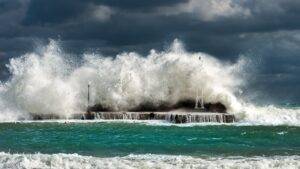 La Niña is a climate pattern that is characterized by cooler-than-average sea surface temperatures in the central and eastern tropical Pacific Ocean. This pattern is the opposite of El Niño, which is characterized by warmer-than-average sea surface temperatures in the same region. La Niña can lead to a variety of impacts on weather patterns around the world, including increased rainfall in some areas and drought in others. It can also have significant impacts on global economic systems, particularly in terms of agriculture and trade. La Niña events typically occur every few years and can last for several months or longer.
La Niña is a climate pattern that is characterized by cooler-than-average sea surface temperatures in the central and eastern tropical Pacific Ocean. This pattern is the opposite of El Niño, which is characterized by warmer-than-average sea surface temperatures in the same region. La Niña can lead to a variety of impacts on weather patterns around the world, including increased rainfall in some areas and drought in others. It can also have significant impacts on global economic systems, particularly in terms of agriculture and trade. La Niña events typically occur every few years and can last for several months or longer.
La Niña can have a variety of impacts on the weather, depending on the region. Some common impacts of La Niña include:
- Cooler and wetter than average conditions in the Pacific Northwest and parts of the northern Rocky Mountains in the United States
- Drier than average conditions in the southern United States, particularly in the Southwest
- Wetter than average conditions in the northern and central parts of South America
- Drier than average conditions in Indonesia and northern Australia
- Wetter than average conditions in eastern Africa
During La Niña events, the United Kingdom and other parts of Europe tend to experience cooler and wetter than average weather conditions. La Niña can also increase the likelihood of Atlantic storms reaching the UK, bringing strong winds and heavy rainfall. These weather conditions can have a variety of impacts, such as flooding, power outages, and travel disruptions. It’s important to note that the specific impacts of La Niña on the UK can vary depending on the strength of the event and other factors.
experience cooler and wetter than average weather conditions. La Niña can also increase the likelihood of Atlantic storms reaching the UK, bringing strong winds and heavy rainfall. These weather conditions can have a variety of impacts, such as flooding, power outages, and travel disruptions. It’s important to note that the specific impacts of La Niña on the UK can vary depending on the strength of the event and other factors.
La Niña is a climate pattern that can occur at any time of the year, although it tends to be more common during the late fall and winter months. The timing of La Niña events can vary, and they can last for several months or longer. La Niña events typically follow El Niño events, which tend to occur during the late fall and early winter months. However, it’s possible for La Niña to occur without an El Niño event preceding it, or for El Niño and La Niña events to overlap. It’s important to note that the impacts of La Niña can vary depending on the strength of the event and other factors, such as the time of year and the presence of other climate patterns.
During La Niña events, it is generally more likely that you will experience wetter than average weather conditions. However, it’s important to note that the specific impacts of La Niña can vary depending on the region you are in and other factors, such as the strength of the event and the time of year. In some areas, La Niña may bring increased rainfall and a higher risk of flooding, while in other areas it may lead to drought conditions. It’s a good idea to stay informed about the local weather forecast and to take appropriate precautions to protect yourself and your property in the event of adverse weather conditions.
 El Niño is a climate pattern that is characterized by warmer-than-average sea surface temperatures in the central and eastern tropical Pacific Ocean. This pattern is the opposite of La Niña, which is characterized by cooler-than-average sea surface temperatures in the same region. El Niño can lead to a variety of impacts on weather patterns around the world, including increased rainfall in some areas and drought in others. It can also have significant impacts on global economic systems, particularly in terms of agriculture and trade. El Niño events typically occur every few years and can last for several months or longer.
El Niño is a climate pattern that is characterized by warmer-than-average sea surface temperatures in the central and eastern tropical Pacific Ocean. This pattern is the opposite of La Niña, which is characterized by cooler-than-average sea surface temperatures in the same region. El Niño can lead to a variety of impacts on weather patterns around the world, including increased rainfall in some areas and drought in others. It can also have significant impacts on global economic systems, particularly in terms of agriculture and trade. El Niño events typically occur every few years and can last for several months or longer.
During El Niño events, the United Kingdom and other parts of Europe tend to experience milder and drier than average weather conditions. El Niño can also decrease the likelihood of Atlantic storms reaching the UK, which can result in fewer strong winds and less heavy rainfall. These weather conditions can have a variety of impacts, such as the reduced risk of flooding and more pleasant conditions for outdoor activities. However, it’s important to note that the specific impacts of El Niño on the UK can vary depending on the strength of the event and other factors.
There are a few steps you can take to prepare for wet weather:
- Stay informed: Keep an eye on the local weather forecast and be aware of any watches or warnings that are in effect.
- Make an emergency kit: Keep a supply of non-perishable food, bottled water, flashlights, and other essential items in case you need to evacuate or if you are stranded at home due to bad weather.
- Protect your property: Take steps to protect your home and property from flood damage. This may include installing flood barriers, sealing basements, and elevating electrical outlets and appliances.
- Have an emergency plan: Know what to do if you need to evacuate, and make sure you have a plan in place for how you will communicate with your family members if you are separated.
- Be prepared for power outages: Keep a supply of backup batteries and make sure you have a way to charge your phone in case of a power outage.
By taking these steps, you can be better prepared to handle wet weather and other adverse weather conditions.
Air pollution can have a number of negative impacts on the environment and human health. However, it is not a direct cause of El Niño or La Niña events. These events are caused by complex changes in sea surface temperatures and atmospheric pressure in the tropical Pacific Ocean, which can lead to shifts in global weather patterns. While air pollution can affect local weather patterns, it is not a major factor in the development of El Niño or La Niña.
The United Kingdom is generally more prone to winter storms due to its location in the North Atlantic Ocean. The UK is situated on the western edge of the European continent, which makes it vulnerable to storms coming from the Atlantic. These storms can bring strong winds, heavy rainfall, and sometimes snow, particularly during the winter months. The UK’s location also makes it susceptible to the impacts of other weather systems, such as cold fronts and low-pressure systems, which can contribute to the formation of winter storms.
 The United Kingdom as a whole is prone to winter storms, although some areas may be more vulnerable than others. Coastal areas are generally more at risk of storm damage due to their exposure to strong winds and high waves. Low-lying areas and those prone to flooding are also more vulnerable to the impacts of storms. Inland areas may also be affected by storms, particularly if they are located on the lee side of hills or mountains, which can channel and amplify the winds. It’s important to stay informed about the local weather forecast and to take appropriate precautions to protect yourself and your property in the event of a storm.
The United Kingdom as a whole is prone to winter storms, although some areas may be more vulnerable than others. Coastal areas are generally more at risk of storm damage due to their exposure to strong winds and high waves. Low-lying areas and those prone to flooding are also more vulnerable to the impacts of storms. Inland areas may also be affected by storms, particularly if they are located on the lee side of hills or mountains, which can channel and amplify the winds. It’s important to stay informed about the local weather forecast and to take appropriate precautions to protect yourself and your property in the event of a storm.